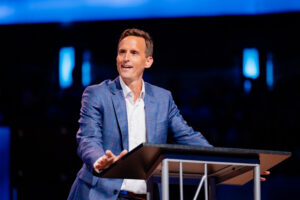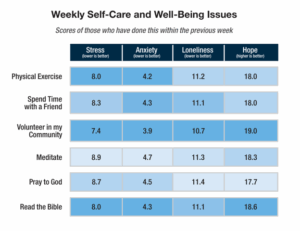
NASHVILLE, Tenn. (BP)–“We just had to cooperate. We had tried everything else. There was no other way.”
Morris H. Chapman, president of the Southern Baptist Convention’s Executive Committee, was quoting the words of Minnie Lou Kennedy James, president of Woman’s Missionary Union when the SBC’s Cooperative Program was begun in 1925.
Years later, just a few months before her death in 1962 at age 90, James said she believed “more than ever” that the Cooperative Program had provided the financial strength to enable Southern Baptists to expand their witness.
Chapman, in highlighting the Cooperative Program’s upcoming 75th anniversary, noted James’ reflections during the opening of the Executive Committee’s Feb. 22-23 meeting in Nashville, Tenn.:
“We would never have grown as we have without it,” said James, WMU’s president from 1916-25. “God led us to start this program. I don’t recall all the reasons, but I’ll be on the other side before long, and everything will be clear. I pray every morning for the Cooperative Program. My part in it was the most important thing I ever did. Tell Baptists to keep it going.”
The 75th anniversary of Southern Baptists’ Cooperative Program will be celebrated with a $750 million goal in giving during the 2000-2001 church year, with the SBC and state conventions partnering to educate Baptists anew of the CP’s importance in Southern Baptists’ efforts to fulfill Christ’s Great Commission for evangelizing and discipling the world’s masses.
The $750 million goal encompasses not only state and national Cooperative Program gifts by church members, but also gifts to the Lottie Moon Christmas Offering for international missions, the Annie Armstrong Easter Offering for North American missions and all state missions offerings for the year 2000-2001 (October through September). The $750 million goal would mark an estimated increase of $60 million to $75 million in giving beyond projections if there were no special stewardship emphasis such as the CP’s 75th anniversary.
Chapman, in addressing the Executive Committee, recapped circumstances surrounding the Cooperative Program’s start in 1925.
Baptist churches in preceding years had conducted special fund drives twice a year — one for the SBC and one for their state convention. Still, receipts fell short of needs. Beyond the special drives, churches additionally were receiving an array of appeals for Baptist causes.
In 1919, the SBC launched a five-year Seventy-Five Million Campaign that yielded a much-celebrated total of $92.6 million in pledges. But problems followed. Actual receipts were only $58.6 million. SBC agencies had tended to spend and borrow against the expected receipts and now found themselves in deep debt.
At the 1925 SBC annual meeting, in addition to the Baptist Faith and Message statement of Baptist beliefs, a recommendation to create the Cooperative Program was approved. But the new CP wasn’t widely celebrated, with Chapman noting that one pastor at the time said the “happiness of former conventions was not evident” on the messengers’ faces. “This was due, perhaps, to the depressing effect of our huge debts,” the pastor said. Another pastor called the 1925 meeting “the least satisfying of all I have attended in 25 years,” while still another said, “The convention struck no high tide. We seemed not to be together.”
But, Chapman said, the significance of the Cooperative Program vote was evident to George W. McDonald, pastor of First Baptist Church, Richmond, Va., and president of the convention.
In McDonald’s sermon the Sunday following the convention, he urged, “Join heartily in the cooperative program for missions. … You, through your messengers, helped to make that program. It represents the combined thought and judgment of Southern Baptists — not my thought, not your thought, not that of any one man — but the combined thought of many. The hope of every board and institution is the success of the cooperative program. Churches and pastors should get behind that program with all their might. Nothing should be allowed to interfere with this main objective. In this church nothing shall…. Here is where I take my stand. Appeals for special objects I cannot heed, for I am going my limit for the program.”
Over the years, Chapman said, the Cooperative Program has become “without dispute, the greatest voluntary funding program in the history of Christendom.”
Currently, Southern Baptists through the Cooperative Program support more than 9,000 missionaries in North America and around the world, Chapman said, quoting a recent report from International Mission Board President Jerry Rankin:
“Recently I met with a group of mission leaders from evangelical denominations and para-church groups. Every one of them testified that the number of missionaries was declining because they were unable to raise sufficient financial support. None of them has a unified plan of giving like the Cooperative Program. They were amazed at our success and dismayed at their increasing decline,” Rankin said.
Additionally, Chapman said, the Cooperative Program assists financially in the theological education of more than 10,000 students through the SBC’s six seminaries. And, among other ministries, it provides “ethical challenge and moral leadership to this nation through the Ethics & Religious Liberty Commission” and relief funds to pastors and their wives “whose retirement income is so meager it just won’t stretch far enough for an existence with dignity,” Chapman said.
The Cooperative Program, he said, is a channel of funding “for state missions, North American missions, world missions, for all peoples throughout the earth who need a Savior.” It is “an alliance and partnership with state Baptist conventions. It is a matter of ‘all for one and one for all.’ … The Cooperative Program is doing together what we cannot do separately.”
Baptists, Chapman urged, “keep it going.”












